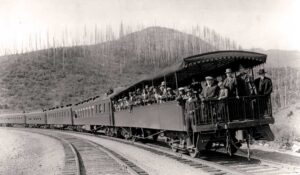Environmental aspects of oil and gas drilling in the United States are subject to at least a half dozen major federal statutes, ranging from the National Environmental Protection Act to the Antiquities Act. These laws apply to oil and gas activities on all lands, public or private, but observers contend that enforcement is more stringent on federal land than on private land. It appears, for example, that federal regulators apply tougher standards on federal lands than private lands when either Native American historical sites or wildlife habitat might be disturbed. This greater stringency presumably yields benefits, but does so at a cost. Recent research by Mitch Kunce, Shelby Gerking, and William Morgan (2002) reveals that this added regulatory burden drives up oil and gas drilling costs by $200,000 per well on federal lands-an increase of some 20 percent.
The authors estimate these added costs with great precision by taking advantage of the “checkerboard” pattern of land ownership seen in many portions of the West. The Wyoming Checkerboard, for example, an important site of recent oil and gas activity, is a 40-mile wide strip of land, composed of 20 miles on each side of the Union Pacific Railroad right-of-way that runs through a 200-mile stretch of southwest Wyoming. The Pacific Railway Acts of 1862 and 1864 conveyed to the railroad both surface and mineral rights to the odd-numbered square-mile sections of land in this area, but kept the even-numbered sections as federal property. The alternating pattern of rights gave ownership maps of the area the appearance of a checkerboard-an appearance retained today, because the ownership pattern is virtually unchanged.
This area is ideally suited to studying the effects of federal regulations, because the law allocated the land without regard for environmental amenities, likelihood of mineral deposits, location, topography, or any of the other factors that might normally be expected to affect drilling costs. To confirm this, Kunce et al. check to ensure that the key determinants of drilling costs are indeed the same on both federal and private lands. These include depth of wells, location, incidence of dry wells, mix of gas versus oil wells, and so forth. Because these other conditions are independent of ownership status, it is reasonable to attribute observed differences in drilling costs to differences in the regulatory stringency applied to activities on federal and private lands.
The authors find that drilling on private land in Wyoming costs about $900,000 per well, while drilling on federal land costs about $1.1 million per well. Over their sample period (1987-99), just over 1400 wells were drilled in this area, roughly 600 on federal land and 800 on private land. Thus, the added costs of the wells drilled on federal lands amounted to about $120 million. It is worth emphasizing that these added costs represent only the extra costs of drilling on federal lands due to the extra stringency of the regulations as applied to federal lands. The authors make no attempt to estimate the total costs of federal regulations for the oil and gas industry.
The authors investigate only drilling costs, because cost comparisons are most direct here. It is more difficult to accurately estimate the impact of stricter regulatory enforcement on oil and gas production costs. For example, production conditions change over time as subsurface pressure declines, causing wells to lose their natural drive. Hence, current production costs can depend on current production and the past pattern of production over time.
The existence of the added drilling costs on federal lands raises a significant issue. If the purpose of the regulations is to provide environmental and historical protection, then regulatory enforcement on the two types of land should be similar. The results of Kunce, Gerking, and Morgan imply that it is not. This suggests that either federal lands are overprotected, or private lands underprotected.
As the authors note, one impact of the higher costs on federal property is a reduction in oil and gas output in an area of the country not particularly noted for its historical or environmental importance. This loss in output surely adds to the pressure to explore in far more sensitive areas, such as national monuments and wildlife refuges, pressure that could be relieved if regulations were eased on federal lands in less sensitive areas. Moreover, the added stringency of regulations on federal lands has resulted in reduced output of oil and gas, which has a cost in itself. Kunce et al. estimate this loss to be nearly $1 billion for Wyoming alone-a state that accounts for only about 10 percent of natural gas reserves in the United States and less than three percent of oil reserves.
If federal lands elsewhere are suffering from output losses proportionate to those found in Wyoming, the nationwide costs of this regulatory stringency are obviously considerable. Perhaps future studies will reveal whether we are receiving comparable benefits in return.
REFERENCE
Kunce, Mitch, Shelby Gerking, and William Morgan. 2002. Effects of Environmental and Land Use Regulation in the Oil and Gas Industry Using the Wyoming Checkerboard as an Experimental Design. American Economic Review 92(December): 1588-93.
Daniel K. Benjamin is a PERC senior associate and professor of economics at Clemson University. His regular column, “Tangents-Where Research and Policy Meet,” investigates policy implications of recent academic research. He can be reached at: wahoo@clemson.edu




